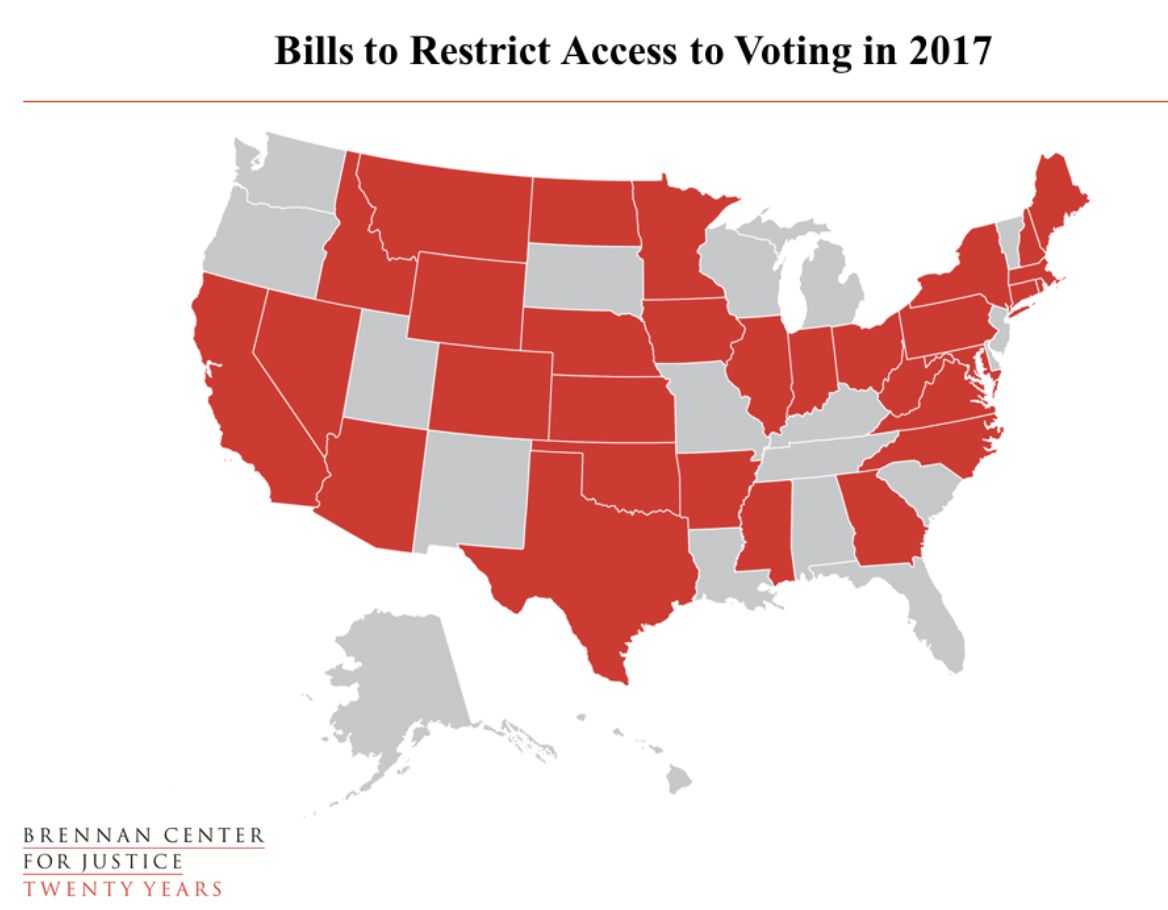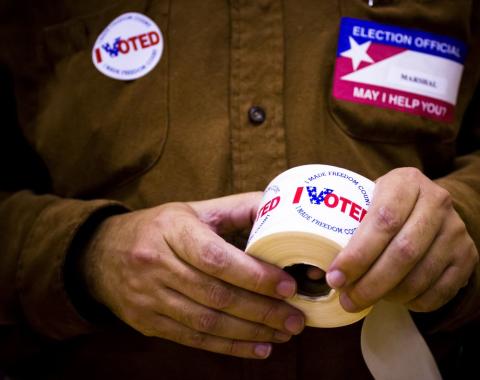Voter suppression is a strategy to influence the outcome of an election by discouraging or preventing people from voting and is different from political campaigning.
Campaigning attempts to change likely voting behavior by changing the opinions of potential voters through persuasion.
Voter suppression attempts to reduce the number of voters who might vote against a candidate or proposition through other means, such as legal hurdles or physical intimidation.
Although one can argue voter suppression has been an issue throughout our entire history, such as not giving women and people of color the right to vote, this post is specifically about a number of recent laws and policies that many people view as purposely limiting the ability of valid voters to actually cast their vote.
A Brief History of Voter Suppression
The oldest form of voter suppression is the United States limiting voting rights to property-owning, white males when our nation was founded. Laws and methods allowing for voter suppression have changed and evolved throughout the last couple centuries.
Throughout the late 19th and early 20th century, Southern states passed Jim Crow laws; state and local laws that enforced racial segregation. Poll taxes, literacy tests, and grandfather clauses (exempt those whose grandfathers had the right to vote before the Civil War) aimed to suppress poor and racial minority voters.
With the Voting Rights Act of 1965, most of these voter suppression methods were made illegal.
The Supreme Court struck down Section Four of the Voting Rights Act in 2013, after they ruled it to be an “antiquated section” of the Act. This section provided a formula for the federal government to use in identifying jurisdictions with problematic histories of racial discrimination in order to fight against different types of voter suppression.
Critics say taking this Act away gives less legal protection for minorities from racially tinged voter laws and redistricting efforts. Since 2013, many cases across the nation have surfaced pertaining to different laws argued to be intentionally discriminatory.
I wrote about the status of the Voting Rights Act more extensively in this post from last year.
Types of Voter Suppression
Voter suppression varies by state and jurisdiction. Below are the most common types of voter suppression.
1) New requirements to vote. These range from requiring proof of citizenship to requiring many, many forms (15 forms in some places) to be filled out in order to register to vote with the state.
2) Voter ID laws: This is an increasingly popular tactic, sometimes likened to a modern-day poll tax, and has the potential to disenfranchise voters who do not have a driver’s license, or who do not have the money or ability to obtain one (a disproportionate share of these people are minorities).
The two main issues here are access to these IDs and money to purchase them. These laws can also have a disproportionate impact on cities, where many people don’t own cars and thus do not have licenses.
3) Packing or dividing majority-minority districts. These redistricting tactics are a form of gerrymandering; manipulating the boundaries of an electoral constituency to favor one party or class. Election maps drawn to push all of a community’s minorities in one or a handful of districts can dilute their voting power.
Similarly, election maps can slice communities into multiple districts so that they have no cumulative influence in any one place.
4) Purging voter rolls: Many states have implemented policies to purge their voter rolls (voter registration rolls on which citizen’s names must appear in order for them to vote). These purges are problematic because they are potentially undoing voters’ registration without their knowledge and if they do not re-register, they cannot vote.
5) Reducing access to voting: Reducing or moving polling places, changing polling hours, or eliminating early voting days. These are issues that affect mostly urban areas which may have issues with long polling lines. Many of these places rely on early voting to register voters and allow them to vote more at their convince to help keep lines shorter.
Longer lines generally discourage people to vote due to the increased amount of time needed to delegate to voting which many people do not have – especially people who work or have families.
6) Limiting mail-in ballots. States can either make specific rules limiting who can mail in ballots or create extra difficulties for people trying to mail their ballots like Arizona did when they made it a felony to collect and turn in someone else’s mail-in ballot, even with the voter’s permission.
7) Changing multi-lingual voter assistance. Making it harder for non-English language speakers to vote (not having translators present or clear, easy to understand instructions) is another way people can be discouraged from voting.
An Interview with Calvin About his Efforts to Combat Voter Suppression
I had the pleasure of speaking with Calvin Starnes from Demand the Vote – a website which serves as an online resource to educate voters about how to register to vote and what is required to vote in their state, along with tracking new state-level legislation that will affect voting and elections.
Calvin was introduced to advocacy about voter suppression through the Action Group Network – “a nationwide network of action groups dedicated to moving the country progressively forward in the wake of a divisive election.”
The laborious and at times challenging process of compiling information for Demand the Vote taught Starnes that there is really no “one-stop shop” people can go to for the information about voting laws and processes in their state.
Demand the Vote aims to keep everyone as informed as possible while offering a decent user experience (aka actually being able to navigate the website and find the information you need – a challenge for many government websites, in my opinion).
When asked about the most pressing matters affecting voter suppression, Starnes highlighted two major issues: securing our elections and voter ID laws.
Voter suppression and how people vote (whether you agree or disagree with the outcome) become almost moot points when you factor in the role election interference can play. If outside actors are purging voter rolls, changing vote counts, influencing the voting public, etc., then all of the work done to increase access to voting and encourage participation in the democratic process could be for nothing.
Starnes made a point to say if you are not content with the federal effort to secure our elections, you can speak to your state representatives and encourage them to do things at the local or state level (you can search for your state representative info on the BillTrack50 legislator search page or via the BillTrack50 app).
The second most pressing issue is voter ID laws, a problem which organizations like Spread the Vote and VoteRiders are trying to improve. Voter ID laws are a problem for a few reasons: time, access and cost.
People need to have time to take off from their life to go get one of these approved IDs, which may mean taking time off work or finding someone to watch their children.
We are all aware of what a nightmare it is to go to the DMV. You then need to have a place where you can get an ID in reasonable proximity to you, accessible via public transportation or a short drive (if you have a car).
Last year in Alabama, stories surfaced of 31 DMV locations being closed down in mostly black areas, where people needed to go to get the kinds of ID needed to vote after they passed a voter ID law.
Finally, getting a new ID costs money. Many people do not have the expendable income to pay $60 for a new ID (plus the previous opportunity costs associated with it discussed above).
Some states have tried to start programs to fund IDs for people, but you need other forms of ID to get those which may also pose a problem.
The Bills
Here is a map of all of the bills containing “photo identification” and “vote” from across the nation in the last four years.
New Hampshire proposed a bill that seems to deter young people from voting. Although it is legal to vote in New Hampshire with an out-of-state license, the law would impose new requirements to “residency”; requiring people who want to vote in the state to have a New Hampshire driver’s license and their car registered in the state – a very expensive cost all car owners know.
Ohio proposed a bill to reduce the minimum number of precinct election officials (poll workers) where poll books are used and to eliminate the requirement to send a notice to a person’s residence address when the board cancels the person’s voter registration because it received a report of the person’s death.
An Oklahoma bill would allow the Secretary of the State Election Board to compare state and federal databases and require the Board to refer any individuals on the voter rolls identified as potential non-citizens to the district attorney.
Some states have been working toward improving access to voting.
Washington enacted the Washington Voting Rights Act of 2018; a state-level version of the Federal Voting Rights Act of 1965, which details the government’s responsibilities to voter equality.
Washington, California, Utah and Maryland have all passed or proposed legislation to improve registration regulations.
Improvements from states include no-excuse absentee voting (Indiana, Maryland and New York), early voting and improving access to voting with disabilities.
Maryland and California have made further moves implementing automatic voter registration.
When examining the current conversation surrounding young people voting, Washington state and California passed bills to help pre-register students to vote and New York would allow an individual who will be 18 years old at the time of a presidential election to vote in the primary election if they are 17.
According to the Brennan Center, in 2017, at least 99 bills were proposed perceived to restrict access to registration and voting in 31 states. Of these bills, 35 bills saw significant legislative action (meaning they have at least been approved at the committee level or beyond) in 17 states.
The laws ranged from voter ID laws to vote roll purges to changing requirements for voter registration.
Conclusion
It has been amazing to see this issue burst into our national discourse. I believe this new awareness is due to people being more politically engaged than ever; it is truly inspiring to see so many people engaging in both policy initiatives and the world around them in general.
Voter suppression is something that affects everyone, everywhere. If we are a truly a democratic country, we need to improve access and encourage participation in the voting process.
We need to look at solutions like changing the day of the election to the weekend, or making it a national holiday. We need to make voting something everyone can participate in. When people engage in their lives and communities, it is better for everyone.
I will leave you with my favorite quote from Calvin Starnes, “You have things you can do, but you have to do them. Find the things, or find someone who knows the things, and then do the things.”
Editor's note: This article originally published on BillTrack50, and has been modified slightly for publication on IVN. It was republished with permission from the author.
Photo Credit: Baiterek Media / shutterstock.com

